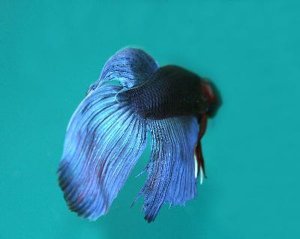
 Betta fish are known for their bright colors and long, flowing fins.
Betta fish are known for their bright colors and long, flowing fins.
Betta splendens are not only one of the most colorful species of freshwater aquarium fish, but also one of the easiest to care for. If you have ever thought about starting a fish tank, consider the betta as a starter fish.
Line the bottom of your 10-gallon betta tank with a soft, dark substrate like sand or gravel. Not only will these substrates give your tank a more natural appearance, but they will also encourage your betta fish to show his best color.
Fill your betta tank with tap water and dose it according to the manufacturer's instructions with an aquarium water conditioner. The water conditioner will remove harmful toxins and chemicals from the tap water, thus making it safe for your betta fish.
Drop an in-tank thermometer into your tank to gauge the temperature of the water. The ideal temperature for a betta tank is between 75 and 80 degrees Fahrenheit.
Install an aquarium heater in your betta tank to help maintain a stable water temperature. Set the thermostat on the heater to a temperature in the 75-to-80-degree range. At the lower end of that range your fish's metabolism will be slower, so he may live longer, though he will not be as active.
Hook up an aquarium filter and insert your preferred filter medium. An aquarium filter will remove solid and dissolved wastes from the water in your betta tank, helping to control ammonia levels and the buildup of organic debris.
Keep the lights on in your betta tank for between 10 and 12 hours per day. While your betta may not require lighting in order to thrive, most live aquarium plants need light to grow. Aquarium lighting will also help show your betta off to best advantage.
Feed your betta fish small amounts of food twice a day. Your betta will thrive on a high-protein diet like betta pellets, but be sure not to give him more than three or four pellets per feeding or he could develop digestive problems.
Offer your betta fish small portions of live and frozen foods such as bloodworms and brine shrimp a few times a week. If your betta seems bloated or constipated, feed him a blanched pea with the skin removed to help clean out his digestive tract.
Monitor the water chemistry in your tank weekly with an aquarium water test kit. If you record the results of these tests each week you will eventually have an idea what the normal levels for your tank are.
Replace your filter medium once a month and perform weekly water changes of up to 20 percent of the tank volume. When performing water changes, siphon dirty water from the substrate of your tank and replace it with fresh tap water that has been treated with aquarium water conditioner.
Items you will need
- 10-gallon tank
- Sand or gravel substrate
- Aquarium water conditioner
- In-tank thermometer
- Aquarium heater
- Aquarium filter
- Filter media
- Aquarium lights
- Betta pellets
- Live and frozen fish foods
- Aquarium water test kit
Warning
- Betta fish are an extremely aggressive and territorial breed—males of the species should not be kept with other fish or with others of their own species. Multiple female bettas can sometimes be kept in community tanks or in tanks with other female bettas but they may still display some aggressive tendencies.









